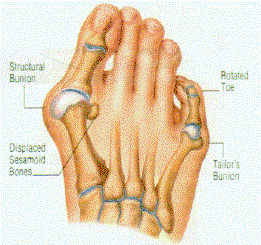A more practical application of this is strong bones that are not at high risk of fracture...bones are constantly depositing calcium and growing new bones from their insides out. Older calcium is released into the blood stream when the body is calcium deficient. It's an ebb and flow, your bones adjust their calcium reserves to maintain a steady level of calcium in the bloodstream. In this process of taking in new material and letting go of the old, they strengthen, weaken, or shape themselves to help you do what you're doing. Since you probably don't know what a strong femur looks like compared to a weak femur (and neither do I!) I'll use a more easily visible example. Bunions are a fairly common feature on feet, a bony process sticking out next to the big toe. No one is born with these - they grow themselves after some time. Common causes include high heels and flat feet, because both of those impede the foot's ability to balance. The foot is struggling, so the bones decide to do something about it and make life easier.

This is happening in all of your bones, all the time, you just can't see it. Any kind of weight-bearing exercise )running, weight-lifting, push-ups, etc.) will force your bones to make themselves stronger. And then they are less likely to break! Usually this isn't a huge concern until later life, but certainly good to know!
No comments:
Post a Comment